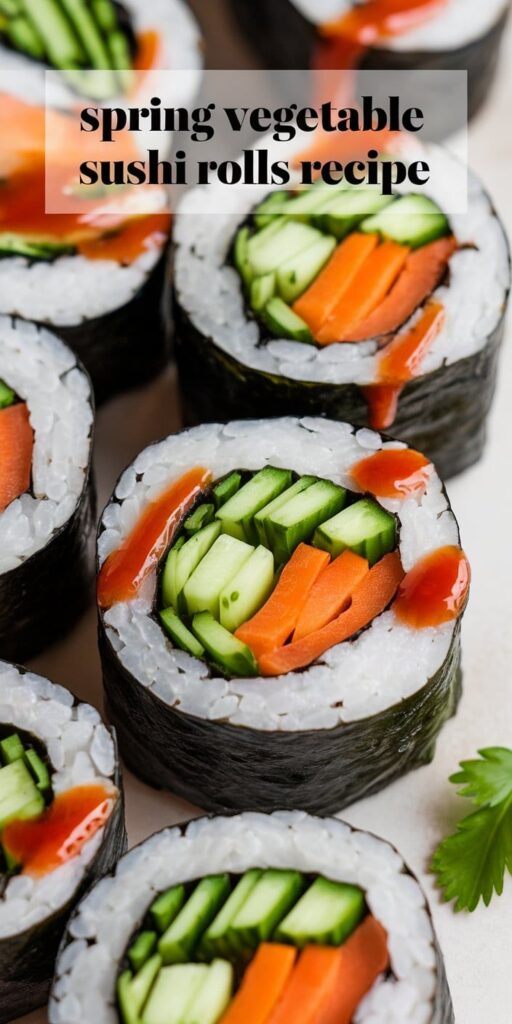Welcome to my culinary adventure into the world of spring vegetable sushi! As a passionate home cook, I’ve discovered that creating homemade sushi rolls can be both exciting and surprisingly simple. This Japanese-inspired recipe celebrates the vibrant flavors of spring, transforming fresh seasonal vegetables into delightful sushi rolls that are sure to impress.
Spring vegetable sushi offers a perfect blend of nutrition and taste. From crisp asparagus to tender radishes, these seasonal ingredients bring remarkable freshness to traditional sushi techniques. The beauty of this recipe lies in its versatility – you can easily customize your rolls based on what’s available at your local farmers market.
In the following sections, I’ll guide you through every step of crafting these delicious rolls. We’ll explore vegetable selection, preparation techniques, and insider tips that will help you create restaurant-quality sushi right in your own kitchen. Whether you’re a sushi novice or an experienced home chef, this recipe promises to inspire your culinary creativity.

Why Spring Vegetables Make Perfect Sushi Fillings
Spring brings a vibrant explosion of fresh produce that transforms sushi from ordinary to extraordinary. As a passionate sushi chef, I’ve discovered that seasonal vegetables for sushi can elevate your rolls to new culinary heights. The crisp, tender vegetables harvested during spring offer unparalleled flavor and nutrition.
Seasonal Vegetables for Peak Flavor
When selecting healthy sushi ingredients, spring provides an incredible array of options. Here are some top picks for vegetable sushi combinations:
- Asparagus: Tender and slightly grassy
- Baby carrots: Sweet and crunchy
- Sugar snap peas: Crisp and refreshing
- Young radishes: Peppery and bright
- Spring onions: Mild and delicate
Health Benefits of Fresh Spring Produce
Spring vegetables pack a powerful nutritional punch. These seasonal gems are loaded with vitamins, minerals, and antioxidants that support overall wellness. By incorporating fresh produce into your sushi, you’re not just creating a delicious meal but also boosting your immune system and promoting better health.
Best Vegetable Combinations for Sushi
Creating the perfect sushi roll is an art of balancing flavors and textures. I recommend mixing crisp and soft vegetables to create interesting contrasts. Try combining julienned carrots with tender asparagus or mixing radishes with cucumber for a refreshing roll that captures the essence of spring.
Essential Ingredients and Equipment for Sushi Making
Creating delicious spring vegetable sushi rolls requires the right sushi-making tools and a carefully curated sushi ingredients list. I’ll walk you through the essential items you’ll need to craft perfect sushi at home.
Sushi Rice Essentials
The foundation of great sushi starts with high-quality rice. You’ll want to invest in short-grain Japanese rice, which provides the perfect sticky texture. A rice cooker helps ensure consistent results, but a heavy-bottomed pot works too.
- Short-grain Japanese rice
- Rice vinegar
- Rice cooker or heavy pot
- Rice paddle for mixing
Key Sushi-Making Tools
Professional sushi preparation requires some specialized equipment. I recommend these must-have tools to make your sushi-making process smooth and enjoyable.
| Tool | Purpose |
|---|---|
| Bamboo Rolling Mat | Create tight, uniform sushi rolls |
| Sharp Chef’s Knife | Precise vegetable and roll cutting |
| Cutting Board | Safe surface for ingredient preparation |
| Kitchen Towels | Clean workspace and hands |
Essential Ingredients
Your sushi ingredients list should include fresh spring vegetables, nori sheets, and key seasonings. Look for crisp, seasonal produce to elevate your sushi rolls.
- Nori seaweed sheets
- Soy sauce
- Wasabi paste
- Pickled ginger
- Sesame seeds
With these sushi-making tools and ingredients, you’ll be well-prepared to create restaurant-quality spring vegetable sushi rolls right in your own kitchen. Remember, practice makes perfect!
Spring Vegetable Sushi Rolls Recipe
Creating the perfect vegetable sushi recipe requires passion, fresh ingredients, and a bit of culinary creativity. These spring vegetable sushi rolls showcase the vibrant flavors of seasonal produce, transforming simple sushi roll ingredients into a delightful culinary experience.
Get ready to explore a delicious vegan sushi options that will impress both home cooks and sushi enthusiasts. This recipe brings together the freshest spring vegetables in a delectable rolled masterpiece.
Prep Time and Serving Size
- Total Prep Time: 45 minutes
- Cooking Time: 20 minutes
- Servings: 4 rolls (approximately 32 pieces)
- Difficulty Level: Intermediate
Ingredient List with Measurements
| Ingredient | Quantity |
|---|---|
| Sushi Rice | 2 cups |
| Nori Sheets | 4 sheets |
| Asparagus | 1 cup, julienned |
| Radishes | 1/2 cup, thinly sliced |
| Baby Spinach | 1 cup |
| Rice Vinegar | 3 tablespoons |
Special Dietary Notes
This vegetable sushi recipe caters to multiple dietary preferences:
- Vegan-friendly
- Gluten-free when using tamari instead of soy sauce
- Low-calorie option
- Can be made with alternative grains for grain-free diets
By using fresh spring vegetables and adaptable ingredients, these sushi rolls offer a versatile and nutritious meal that everyone can enjoy.
Mastering Sushi Rice Preparation
Creating perfect sushi rice is an art that transforms ordinary ingredients into an extraordinary culinary experience. My journey into rice cooking techniques has taught me that precision is key when preparing the foundation of delicious sushi rolls.
The secret to perfect sushi rice begins with selecting the right type of rice. Short-grain Japanese rice, specifically designed for sushi, provides the ideal sticky texture essential for creating well-formed rolls. I recommend using high-quality short-grain white rice that will ensure your sushi rice seasoning delivers maximum flavor.
- Rinse rice thoroughly to remove excess starch
- Use precise water-to-rice ratio (typically 1:1.1)
- Cook rice in a rice cooker or heavy-bottomed pot
- Allow rice to rest after cooking for optimal texture
Sushi rice seasoning is crucial for authentic flavor. I prepare a mixture of rice vinegar, sugar, and salt that gets folded into the warm rice. The key is to mix gently, using a cutting motion to avoid crushing the delicate grains while evenly distributing the seasoning.
Cooling the rice properly is the final critical step in rice cooking techniques. I spread the seasoned rice in a large, shallow container and fan it gently. This method helps the rice cool quickly while maintaining its glossy appearance and preventing it from becoming mushy.
With practice, you’ll develop the skills to create restaurant-quality sushi rice that serves as the perfect canvas for your spring vegetable rolls.
How to Properly Cut and Prepare Spring Vegetables
Preparing vegetables for sushi is an art that requires precision and skill. Mastering vegetable cutting techniques will elevate your sushi rolls from good to exceptional. I’ll guide you through the essential methods to transform fresh spring vegetables into perfect sushi fillings.
Sushi filling preparation begins with selecting the right vegetables and using proper cutting methods. The key is to create uniform, thin pieces that will integrate seamlessly into your rolls.
Julienne Cutting Technique
The julienne cut is crucial for sushi vegetable preparation. I recommend following these steps:
- Use a sharp chef’s knife for clean cuts
- Trim vegetables to create flat surfaces
- Slice vegetables into thin, matchstick-sized strips
- Aim for pieces approximately 1/8 inch thick
- Keep cuts consistent for even rolling
Blanching Methods for Crisp Vegetables
Blanching vegetables for sushi helps maintain vibrant colors and optimal texture. Here’s my preferred technique:
- Boil water in a large pot
- Prepare an ice bath in a separate bowl
- Briefly submerge vegetables in boiling water (30-60 seconds)
- Immediately transfer to ice bath to stop cooking
- Drain and pat dry before using
Size and Shape Guidelines
Creating the perfect vegetable pieces for sushi requires attention to detail. I suggest keeping vegetable strips:
- Approximately 4 inches long
- Uniformly thin (1/8 to 1/4 inch wide)
- Visually appealing and consistent
With these techniques, you’ll transform ordinary vegetables into professional-quality sushi fillings that look and taste amazing.
Rolling Techniques for Perfect Sushi
Mastering sushi rolling methods requires practice and precision. The bamboo mat technique is essential for creating tight sushi rolls that look professional and taste delicious. I’ll walk you through the key steps to transform your home sushi-making experience.
Start by preparing your workspace with all necessary tools. A bamboo mat is crucial for achieving consistent, tight sushi rolls. The mat helps compress the ingredients and create a uniform shape that holds together perfectly.
- Place the bamboo mat on a clean surface
- Cover the mat with plastic wrap to prevent sticking
- Lay a sheet of nori seaweed on the prepared mat
- Spread sushi rice evenly, leaving a small border at the top edge
When arranging ingredients, less is more. Overfilling can make rolling difficult and cause your rolls to fall apart. Carefully place your spring vegetables in a straight line across the rice, ensuring even distribution.
| Rolling Technique | Key Tips |
|---|---|
| Initial Lift | Gently lift the edge of the mat closest to you |
| First Roll | Compress ingredients while rolling forward |
| Final Compression | Use mat to shape and tighten the roll |
The key to perfect sushi rolls is consistent pressure and smooth motion. Use your fingers to guide the roll and the bamboo mat to create tight, uniform shapes. With practice, you’ll develop the confidence to create restaurant-quality sushi at home.
Sauce and Garnish Suggestions
Elevating your spring vegetable sushi rolls goes beyond the basic preparation. The right sushi dipping sauces and creative toppings can transform a simple roll into a culinary masterpiece. Let’s explore ways to enhance flavor and presentation that will impress both your eyes and taste buds.
Traditional Dipping Options
Classic sushi dipping sauces are essential for bringing out the subtle flavors of your vegetable rolls. I recommend a few traditional choices that complement spring vegetable sushi:
- Shoyu (traditional soy sauce)
- Ponzu citrus sauce
- Wasabi-soy sauce blend
- Tamari for gluten-free option
Creative Modern Toppings
Experiment with sushi toppings that add texture and excitement to your rolls. These modern garnishes can elevate your presentation:
- Toasted sesame seeds
- Micro greens
- Crispy shallots
- Spicy mayo drizzle
- Furikake seasoning
Sushi Plating Ideas
Presentation matters as much as taste when serving sushi. My favorite sushi plating ideas include using:
| Plating Technique | Visual Impact |
|---|---|
| Asymmetric arrangement | Modern, artistic look |
| Colorful garnish placement | Vibrant and appetizing |
| Geometric cutting style | Precise and professional |
Remember, the goal is to create a visually stunning and delicious spring vegetable sushi experience that delights all senses.
Storage Tips and Make-Ahead Options
When preparing make-ahead sushi rolls, proper storage is key to maintaining freshness and flavor. I recommend wrapping your rolls tightly in plastic wrap and storing them in an airtight container in the refrigerator. These storing sushi rolls techniques will help preserve the quality of your spring vegetable sushi for up to 24 hours.
For those looking to prep ingredients in advance, I suggest separating rice, vegetables, and nori sheets. Cooked sushi rice stays fresh for 2-3 days when refrigerated in a sealed container. Prepped vegetables can be julienned and stored in water to prevent oxidation, making your leftover sushi ideas quick and easy to assemble when hunger strikes.
If you find yourself with extra ingredients, get creative! Transform your remaining sushi components into delightful salads, rice bowls, or quick stir-fry dishes. These make-ahead sushi strategies not only reduce food waste but also provide versatile meal options for busy home cooks. Just remember to consume refrigerated sushi within 1-2 days for optimal taste and safety.
My top tip is to keep components separate until you’re ready to roll. This approach ensures crisp vegetables and perfect texture, giving you the flexibility to create fresh sushi whenever the craving hits. With these storage methods, your spring vegetable sushi can be a convenient and delicious meal option any time.



